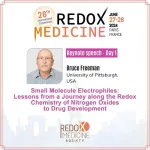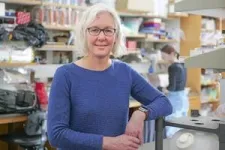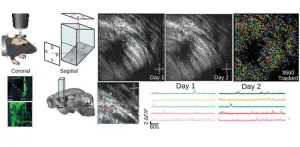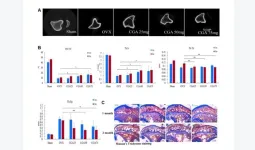(Press-News.org) Bruce A. Freeman, Irwin Fridovich Distinguished Professor and Chair at the University of Pittsburgh School of Medicine Department of Pharmacology & Chemical Biology, will introduce Redox Medicine 2024 with a key note talk titled "Small Molecule Electrophiles: Lessons from a Journey through Studying the Redox Chemistry of Nitrogen Oxides to Drug Development”.
The 26th International Conference of the Redox Medicine, Redox Medicine 2024, will take place on June 27-28 at Fondation Biermans Lapôtre in Paris, France.
Professor Freeman will discuss the generation and actions of nitrogen oxide-derived fatty acid nitroalkenes in the context of their cell signaling actions, physiological responses and potential therapeutic effects as synthetic drug candidates.
Contributions of Professor Bruce A. Freeman to Redox Biology
The research conducted by Professor Bruce. Freeman focuses on the study of oxidizing and free radical inflammatory mediators, including superoxide, hydrogen peroxide, nitric oxide (NO), and peroxynitrite, in the context of cellular signaling and disease mechanisms.
Professor Freeman's laboratory has identified important roles for reactive oxygen and nitrogen species in cellular signaling and disease processes. Initial research established the cellular sources of superoxide and hydrogen peroxide. Subsequent work revealed that NO interacts with superoxide to produce reactive nitrogen species, expanding the known functions of NO in cellular signaling beyond the activation of guanylate cyclase.
Additionally, Freeman's research into peroxynitrite, generated by the reaction of NO with superoxide, has highlighted its role in cellular dysfunction and disease. The laboratory's findings on the actions and targets of peroxynitrite have provided insights into the mechanisms of disease previously attributed to its precursor molecules.
Professor Freeman's research has contributed significantly to the understanding of redox biology, particularly in terms of the roles of reactive species in cellular signaling and disease. These contributions have implications for developing therapeutic strategies for diseases related to oxidative stress and inflammation.
Speakers Lineup of Redox Medicine 2024
Miria Ricchetti, Institut Pasteur, France – Keynote Speech on Day 2: “Redox Interactome in Physiopathology”
Bruce Freeman, University of Pittsburgh, USA – “A Nitroalkene-Based Therapy for Parkinson’s Disease – Preclinical Results”
Mario D. Cordero, Universidad Pablo de Olavide, Spain – “Mechanism of the SuperInflammasome Complexes in Human Diseases and Redox Signaling”
Christel Marquette, Commissariat à l'Energie Atomique et aux Energies Alternatives (CEA), France – "Neuroinflammation, Alzheimer's Disease and Cell Death: Role of Redox"
Zaher El Beck, Karolinska Institutet, Sweden – “Epigenetic Modulators Link Mitochondrial Redox Homeostasis to Cardiac Function”
Tamara Tomin, TU Wien, Austria – “Metabolic regulation by Redox Signaling in the Heart”
Daniel Vaiman, DR1 INSERM, Institut Cochin, France – “New Insights into the Impact of Oxidative Stress in Hypertensive Diseases of Pregnancy”
Martin O. Bergö, Karolinska Institutet, Sweden – “Antioxidants Stimulating Blood Flow in Tumors”
Laurent Chatre, ISTCT, CNRS, Université de Caen Normandie, France – "The Reactive Species Interactome, Mitochondria, and the Gender-Brain Metabolism Nexus”
Miquel Mulero Abellán, Universitat Rovira i Virgili, Spain – “Redox in Gut Health and Nutrigenomics: Recent Advances and Perspectives”
Roberta Rizzo, Università degli Studi di Ferrara, Italy – “NADH: The Redox Sensor in Aging-Related Disorders”
Andrew Cumpstey, University of Southampton, United Kingdom – “Redox Implications of Supplementary Oxygen during Major Abdominal Surgery”
Carole Nicco, President of Redox Medicine Society – “Redox Medicine 2024: Biomarkers”
Sayuri Miyamoto, University of São Paulo, Brazil – “Identifying Oxidized Lipids in Neurodegenerative Diseases”
Jumana Saleh, Sultan Qaboos University, Oman – “Exploring Predictors of HDL Oxidative Stress Functionality in Post-Covid Disease and Relation to Severity”
Radia Tamarat, Institut de Radioprotection et de Sûreté Nucléaire (IRSN), France – "Redox, Radiotherapy and Biomarkers"
Govindasamy Mugesh, Indian Institute of Science, India – “Antioxidant and Prooxidant Nanozymes: From Cellular Redox Regulation to Next-Generation Therapeutics”
Jeffrey A. Johnson, University of Wisconsin, USA – “Targeting ‘Undruggable’ Proteins: New Approach for Treating Neurodegenerative Diseases”
George M. Spyrou, The Cyprus Institute of Neurology & Genetics, Cyprus – “Drug repurposing on Alzheimer's disease & NRF2 Modulation”
Stéphane Mouchabac, Hôpital Saint-Antoine, APHP, France – “Artificial Intelligence in NeuroInflammation, Biomarkers and Redox Medicine”
Maxime Barat, Université Paris Cité, Hôpital Cochin, France – "Artificial Intelligence & Algorithms: Applications in Redox Medicine & Radiology"
Duncan Emerton, Vice-President of Citeline, United Kingdom – “Pharma’s Search for Redox-Modulating Therapeutics”
Antonio Vila-Coro, IQVIA, Spain – “How to Develop a Drug – From Preclinical to Clinical”
More about Redox Medicine 2024
Program
Speakers
Call for abstracts
Supporters: Citeline and Mitologics
About Redox Medicine Society
Since 1998, the Redox Medicine Society (RMS), former ISANH, is dedicated to advancing the understanding and application of redox science in health and disease. RMS aims to facilitate the translation of basic knowledge of redox science into molecular medicine and to discover innovative new approaches to prevention, diagnosis and treatment. Through conferences, publications, and collaborations, the society seeks to promote innovation and excellence in the field of Redox Medicine and Science.
END
PHILADELPHIA – Patients being treated for B-cell non-Hodgkin’s Lymphoma (NHL) who are part of minority populations may not have equal access to cutting-edge CAR T cell therapies, according to a new analysis led by researchers from the Perelman School of Medicine at the University of Pennsylvania and published today in NEJM Evidence.
CAR T cell therapy is a personalized form of cancer therapy that was pioneered at Penn Medicine and has brought hope to thousands of patients who had otherwise run ...
The beautiful, gnarled, nooked-and-crannied reefs that surround tropical islands serve as a marine refuge and natural buffer against stormy seas. But as the effects of climate change bleach and break down coral reefs around the world, and extreme weather events become more common, coastal communities are left increasingly vulnerable to frequent flooding and erosion.
An MIT team is now hoping to fortify coastlines with “architected” reefs — sustainable, offshore structures engineered to mimic the wave-buffering effects of natural reefs while also providing pockets for fish and other marine ...
University of Maryland School of Medicine (UMSOM) Dean Mark T. Gladwin, MD, announced today that Martine Rothblatt PhD, JD, MBA, Chairperson and CEO of United Therapeutics, and inventor of SiriusXM Satellite Radio, will deliver the keynote address for this year’s graduating medical student class. The UMSOM MD graduation ceremony will take place at the Hippodrome Theatre on Thursday, May 16, 2024. The ceremony will begin at 1:00 pm. Details for faculty members are here. Details for students/guests are here.
Dr. Rothblatt is a trailblazing pioneer of several innovations in biotechnology, pharmaceuticals, and satellite communications. After developing SiriusXM, ...
The ORIGAMI (Optimized Resource Integration and Global Architecture for Mobile Infrastructure for 6G) project is now underway. The project, funded by the European Commission under the Horizon Europe program, will spearhead architectural innovations for the next generation of 6G mobile networks, to enable innovative applications, new business models, and substantial reductions in energy consumption.
By proposing and developing three critical architecture innovations – Global Services Based Architecture (GSBA), Zero Trust Exposure Layer (ZTL), and Continuous Compute ...
New research says the wide variety of skills displayed by people with conditions such as ADHD, dyslexia and autism should be celebrated to help reduce stigma and change society’s expectations.
Creativity, resilience and problem-solving are just some of the strengths exhibited and a study is now calling for a change in the way we think about people with neurodevelopmental conditions.
Dr Edwin Burns, senior lecturer from the School of Psychology at Swansea University, worked with academics from Edge Hill University on the study and their findings have just been published by ...
Local and state governments have a variety of tools at their disposal to attract businesses or entice them to stay. One is tax relief. Austin, for example, helped lure electric automaker Tesla in part with property tax rebates worth $14 million over 10 years.
In a study released today from Texas McCombs, Dean and Accounting Professor Lillian Mills finds that another kind of government aid — cash grants — has a different kind of impact. It helps companies lighten their balance sheets by borrowing less.
Corporations ...
TUCSON, Ariz., March 26, 2024 — Critical Path Institute (C-Path) is excited to announce the launch of the Critical Path for Alpha-1 Antitrypsin Deficiency (CPA-1) Consortium. The CPA-1 consortium aims to accelerate drug development for alpha-1 antitrypsin deficiency (AATD), a rare disease that affects individuals and families worldwide. This will be achieved by integrating data through C-Path’s Rare Diseases Cures Accelerator–Data Analytics Platform (RDCA-DAP®) and leveraging those data for CPA-1 to collaboratively develop regulatory-grade solutions to continuously address unmet needs in drug development for this condition, including:
Generating evidence to ...
COLUMBUS, Ohio – When the skeletal remains of a giant ground sloth were first unearthed in 1796, the discovery marked one of the earliest paleontological finds in American history.
The animal, named Megalonyx by Thomas Jefferson in 1799, was the first genus of fossil named from the United States. Thought to have roamed North America during one of the last ice ages, the extinct giant ground sloth was an herbivorous mammal resembling a large bear — at full size, it likely reached nearly 10 feet tall (3 meters) and weighed about as much as a small elephant.
The report made by Jefferson, an avid fossil collector who was known to keep ...
Organisms constantly face the challenge of adapting their behavior to survive in a world full of uncertainties. This ability relies on complex neural circuits in the brain that help them find resources while avoiding danger. Scientists study how these neural circuits change over time to understand better how behaviors emerge.
One powerful way to study these changes is through optical imaging techniques that allow researchers to track the activity of individual brain cells. Traditional methods rely on observing the activity of cells directly, ...
“[...] chlorogenic acid appears to be a promising candidate for the management of osteoporosis.”
BUFFALO, NY- March 26, 2024 – A new research paper was published in Aging (listed by MEDLINE/PubMed as "Aging (Albany NY)" and "Aging-US" by Web of Science) Volume 16, Issue 5, entitled, “Chlorogenic acid prevents ovariectomized-induced bone loss by facilitating osteoblast functions and suppressing osteoclast formation.”
Osteoporosis is a common bone disease in ...





